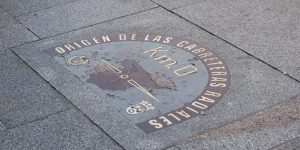It looks simple. You’re driving along when the navigator indicates your next turn. You’re almost there, that’s great. But just how are these distances measured? How is all this information about the highway system organized to allow us to find our way on the map?
In the case of Spain, on the roads and highways the numbered exits correspond to that kilometric point. In other words, exit 31 is situated at kilometer 31, for example. So that if you are at km 15, you know that there are 16 more until you reach exit 31. Or, if you are at km 50, going in the opposite direction, there are still 19 to go. And all of this is tabulated starting with the legendary kilometer 0, at the Puerta del Sol in Madrid.
The six Spanish radial highways
History always turns out to be more complex. But let’s start at the beginning, the cornerstone of today’s GPS system, with the definitive distinction made in the 1930s regarding national, regional and local roads. The axis that guides us are the six radial highways, running clockwise from 1 to 6. They begin at the north with the A-1 from Madrid through Burgos to Irún, on the French border; then the A-2 from Madrid to France passing through Barcelona; the A-3 from Madrid to Valencia; the A-4 from Madrid to Cádiz in the south; the A-5 from Madrid to Portugal after passing through Badajoz; and the A-6 from Madrid to A Coruña in northwest Spain.
The kilometric point, our eternal compass
“The numbers of the exits on the highways tend to follow one of these schemes,” says Manuel Romana, professor of Highways at the School of Engineering of Roads, Canals and Ports at the Universidad Politécnica de Madrid (UPM).
“First, on highways with many adjoining roads, the usual approach is to label them with the kilometric point because more intermediary links can –and usually are– built, and this can complicate any other numbering system. And second, on highways with few links –normally toll roads– they tend to be numbered by order, since more interchanges are not likely to be built. On earlier toll roads, the total number of exits were numbered starting with 1. It is worth remembering that, in the past, the construction of a toll road link was a relatively difficult undertaking and required the hiring of more workers from the area. Now, with automatic and high-speed tolls, things have changed and almost all detours are labeled by kilometric point”, he points out.
Interestingly, when there are several exits at the same kilometric point, letters are added: for example, 15A, 15B, and so on. Or, if you see one large and one small number on the sign, they each refer to the kilometric point and the hectometers. This is —another example— km 15,600 of the highway. The new R2- and R3-type radial roads run parallel to the original or main ones, which also mark the first digit of the secondary roads. How? If the road starts from the A-4, that’s where the N-420 would come from, among other roads. Yes, the subject is wide-ranging if we look at it in detail. And, in the end, in this hyper-connected world, everything fits. And it is not a trivial matter: just in Spain, according to the Ministry of Transport, Mobility and Urban Agenda, there are more than 165,400 kilometers of asphalt.

Road epicenter: “kilometer 0” / “kilometer zero”
“The notion of kilometer 0 dates back to 1761, but its materialization in the Puerta del Sol took place in 1856. The precise location is much more recent; and the current one is from the 21st century”, says the expert from the UPM, who recommends a visit to the Centro de Interpretación de la Caminería in La Cerradura (Jaén), where they house “milestones from all eras, starting with replicas of Roman milestones”. Now let’s go back to kilometer 0. In the 18th century, Romana tells us, engineers worked on “the concept of radial roads from Madrid, and many years later, with the Royal Order of December 18, 1856, it was set out that all roads exiting Madrid were to be marked with milestones at each kilometer, establishing that the origin was shared by all”.
In other nations, the equivalent of kilometer zero—note that in Spain it does not strictly refer to the center of the country— also marks its geographical location as a measure of distance. This criterion began in the Forum of Rome, when Emperor Caesar Augustus (27 BC – 14 AD) placed a bronze monument —called Milliarium Aureum— next to the temple of Juno so that all distances of the Empire were counted from there. And, of course, we know where all roads lead.
In Europe there is the European Road Network, which covers all the roads that pass through the continent under a common nomenclature. Here, the numbering does not refer to the type of road or the presence of seas or mountains on the route. They are based on a European grid and can be recognized by the letter E appearing along national road nomenclature.
In the United States, on the other hand, the two-digit U.S. Routes follow a simple rule: odd-numbered routes generally run from south to north and even-numbered routes from west to east. The fact is that, in theory, your GPS will never lose its way anywhere in the world.